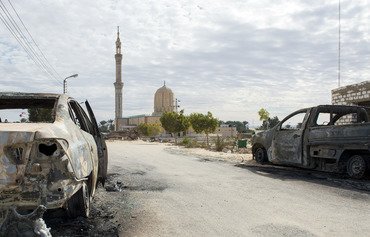Egypt's vast Western Desert near the border with Libya has become an arena of fierce clashes between the Egyptian army and various armed extremist groups.
Egyptian forces have been attacked on main roads traversing the desert, which covers a total area of about 681,000 square kilometres.
Suicide attacks targeting civilians also have been planned and executed by extremist cells operating in the desert, which extends 1,000 kilometres north to south and 600 kilometres east to west, bordering Libya.
In response to these security breaches, and to thwart the smuggling of arms from Libya, army and police forces have launched raids and airstrikes that have killed dozens of militants, and have pursued others deep into the desert.
Most recently, Egyptian forces have been making intensified efforts to apprehend extremist elements following a deadly October 20th attack on a contingent of policemen near Wadi al-Hitan.
According to the Interior Ministry, armed extremists attacked the contingent as it was on its way to raid a terrorist hideout in al-Wahat al-Bahriya, killing 16 policemen and wounding 13 others.
Following the operation, the army carried out several ground operations and airstrikes in co-operation with the police, killing the perpetrators.
Cross-border smuggling
The Egyptian army has been able to thwart many attempts to smuggle weapons into Egypt across the Libyan border.
On June 27th, the army destroyed 12 four-wheel-drive vehicles loaded with weapons, ammunition and explosives as they attempted to cross from Libya.
Egyptian forces on July 16th foiled another attempt to smuggle arms into the country through its western border with Libya.
And on October 30th, the army foiled yet another attempt to smuggle arms across the border, destroying six four-wheel drive vehicles and killing all the "criminal elements" inside, the armed forces said in a statement.
"Egypt's border guard units, along with the air force, are combing the western borders in the area of the operation," the statement said.
Trouble in the Western Desert
Trouble began to brew in the Western Desert in July 2014, when extremists attacked a border guard checkpoint in al-Farafra in al-Wadi al-Jadid, killing 29 army officers and conscripts. Fourteen extremists were killed in the clash.
Egypt's military prosecution later revealed the July 19th attack had been led by Hisham Ali Ashmawi, a dismissed Egyptian army officer who headed a cell of extremist group Ansar Bayt al-Maqdis.
Ansar Bayt al-Maqdis later pledged allegiance to the "Islamic State of Iraq and Syria" (ISIS), and has been operating under the name Wilayat Sinai.
"This attack led to a change in the military strategy implemented in relation to positioning security checkpoints along major roads in the Western Desert," said Iman Ragab, an expert at Al-Ahram Centre for Political and Strategic Studies.
At that time, she told Al-Mashareq, the army began conducting periodic aerial patrols in areas where terror elements are suspected of setting up hideouts.
"Since this operation was launched, disputes emerged within Ansar Bayt al-Maqdis," she said, and the group’s leader, Abu Hammam al-Ansari, pledged allegiance to ISIS to garner financial and other support.
"However, Ashmawi did not agree with him on this matter and decided to flee with a number of his followers to Libya to form a new group there," she said.
After Ansar Bayt al-Maqdis pledged allegiance to ISIS, al-Ansari put Ashraf al-Gharbali in charge of the group's cell in the Western Desert, she said.
The cell carried out its second operation in July 2015 -- its first under ISIS command -- kidnapping and beheading Croatian oil engineer Tomislav Salopek.
In November 2015, police killed al-Gharbali in Cairo, after the Interior Ministry received information that he had been frequenting the area to plan an attack.
Tracking down extremists
Attacks in the Western Desert abated to some extent after al-Gharbali’s killing, until the cell, under the command of new leader Waleed Hussein, killed eight police officers on May 8th, 2016, in Helwan, south of Cairo.
Intelligence services tracked down Hussein and two associates in the Ras al-Bar area near the northern border with Libya, and killed them on July 6th, 2016.
After suffering mounting losses in the Western Desert, the extremists regrouped, appointing Izzat Muhammad Hassan, also known as Izzat al-Ahmar, as the cell’s commander, said Ahmed Ban, an expert on extremist groups.
"Izzat was known for his expertise in the manufacture of explosives and in weapon development," he told Al-Mashareq.
Investigations confirmed that "Izzat supported an ISIS member in southern Egypt, Amr Saad Abbas, and provided him with funding", Ban said.
The new cell, led by al-Ahmar and Abbas, carried out an attack against Coptic civilians in December 2016, in which cell member Mahmoud Shafiq Mohammed blew himself up inside a church in Cairo, killing 25 people.
Targeting desert hideouts
A month later, on January 16th, 2017, the cell carried out another attack -- this time in the heart of the Western Desert -- killing eight policemen at a checkpoint in al-Wadi al-Gadid and injuring three others.
Two of the attackers were killed when security forces fought back, the Interior Ministry said, adding that the attack took place at al-Naqab checkpoint, about 80 kilometres from the provincial capital of al-Kharga city in the Western Desert.
The attacks on the Coptic Church in Cairo and al-Naqab checkpoint "were two of the most dangerous attacks carried out by ISIS's cell in the Western Desert", said Nasser Military Academy adviser Maj. Gen. Tharwat al-Nasiri.
"The army and police forces launched large-scale operations against the cell and killed many of its members, and as a result the number of attacks has dropped," he told Al-Mashareq.
Many of the militants fled deep into the desert and are either being hunted down or staying out of sight in a mountain hideout, he added.

![Egyptian soldiers inspect the site of a 2014 attack in the Western Desert near al-Farafra oasis in al-Wadi al-Gadid, in which 21 border guards were killed. [Stringer/AFP]](/cnmi_am/images/2017/11/07/10276-Egypt-western-desert-600_384.jpg)





